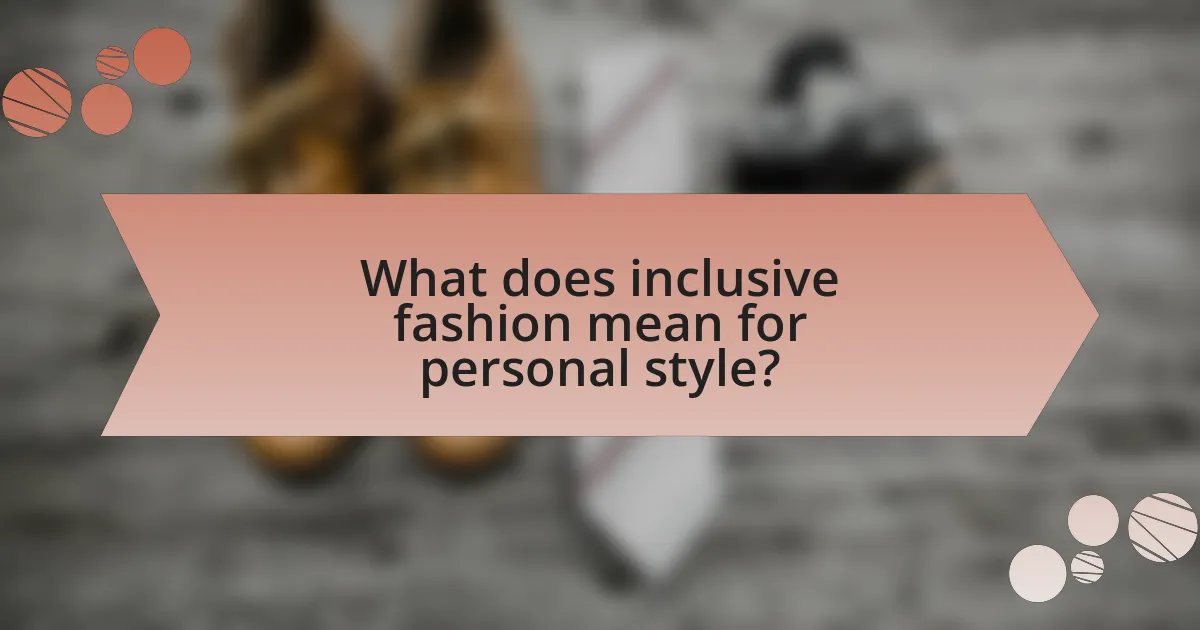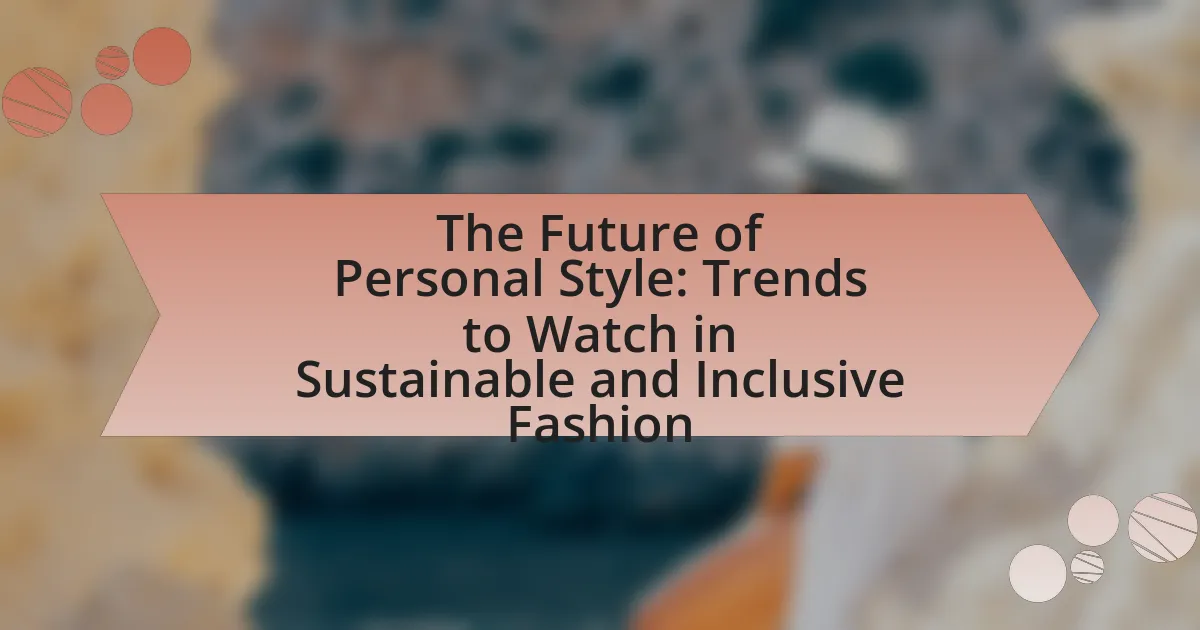The article examines the future of personal style through the lens of sustainable and inclusive fashion trends. It highlights key developments such as circular fashion, innovative materials, and the demand for transparency in supply chains, which are reshaping consumer choices. The discussion includes the prioritization of eco-friendly materials, the influence of sustainability on purchasing behaviors, and the importance of representation in fashion marketing. Additionally, it addresses how consumers can engage with sustainable practices and advocate for inclusivity, ultimately contributing to a more responsible and diverse fashion industry.

What are the emerging trends in sustainable fashion?
Emerging trends in sustainable fashion include the rise of circular fashion, the use of innovative materials, and increased transparency in supply chains. Circular fashion focuses on designing products for longevity, repairability, and recyclability, reducing waste and promoting resource efficiency. Innovative materials, such as bio-based fabrics and recycled textiles, are gaining traction, with brands like Stella McCartney leading the way in using sustainable alternatives. Additionally, consumers are demanding greater transparency, prompting brands to disclose their sourcing practices and environmental impact, as seen in initiatives like the Fashion Transparency Index, which evaluates brands on their sustainability efforts.
How is sustainability reshaping personal style?
Sustainability is reshaping personal style by driving consumers to prioritize eco-friendly materials and ethical production practices in their fashion choices. This shift is evident as brands increasingly adopt sustainable practices, such as using organic fabrics, reducing waste, and ensuring fair labor conditions. For instance, a report by McKinsey & Company indicates that 67% of consumers consider the use of sustainable materials important when making a purchase. Consequently, personal style is evolving to reflect a commitment to environmental responsibility, with individuals opting for timeless, versatile pieces that minimize their ecological footprint.
What materials are being prioritized in sustainable fashion?
Sustainable fashion prioritizes materials such as organic cotton, Tencel, hemp, recycled polyester, and biodegradable fabrics. Organic cotton is favored for its reduced pesticide use, while Tencel, made from sustainably sourced wood pulp, is known for its low environmental impact. Hemp is valued for its durability and minimal water requirements. Recycled polyester, derived from post-consumer plastic bottles, helps reduce waste and resource consumption. Biodegradable fabrics, like those made from natural fibers, are increasingly sought after for their ability to decompose without harming the environment. These materials collectively contribute to a more sustainable fashion industry by minimizing ecological footprints and promoting responsible sourcing practices.
How do sustainable practices influence consumer choices?
Sustainable practices significantly influence consumer choices by increasing demand for eco-friendly products. Research indicates that 66% of global consumers are willing to pay more for sustainable brands, reflecting a shift towards environmentally responsible purchasing behaviors. This trend is driven by heightened awareness of environmental issues and a desire for ethical consumption, leading consumers to favor brands that demonstrate commitment to sustainability through transparent practices, such as using recycled materials or reducing carbon footprints.
Why is transparency important in the fashion industry?
Transparency is important in the fashion industry because it fosters trust between brands and consumers, enabling informed purchasing decisions. When brands disclose their supply chain practices, labor conditions, and environmental impact, consumers can assess the ethical implications of their purchases. For instance, a 2021 survey by McKinsey & Company found that 67% of consumers consider sustainability and transparency when making fashion choices. This demand for transparency encourages brands to adopt more sustainable practices, ultimately leading to a positive shift in the industry towards ethical production and consumption.
What role do certifications play in sustainable fashion?
Certifications play a crucial role in sustainable fashion by providing a standardized framework for assessing and verifying the environmental and social practices of fashion brands. These certifications, such as Global Organic Textile Standard (GOTS) and Fair Trade, ensure that products meet specific sustainability criteria, which helps consumers make informed purchasing decisions. For instance, GOTS certification requires compliance with strict environmental and social criteria throughout the entire supply chain, from raw material sourcing to manufacturing processes. This transparency fosters trust between consumers and brands, encouraging more sustainable practices in the industry.
How can consumers identify sustainable brands?
Consumers can identify sustainable brands by looking for certifications, transparency in sourcing, and eco-friendly practices. Certifications such as Fair Trade, GOTS (Global Organic Textile Standard), and B Corp indicate adherence to sustainability standards. Brands that provide detailed information about their supply chain and production processes demonstrate transparency, which is a key indicator of sustainability. Additionally, companies that utilize recycled materials, reduce waste, and implement ethical labor practices further establish their commitment to sustainability. Research shows that consumers increasingly prefer brands that align with their values, with 66% of global consumers willing to pay more for sustainable brands, according to a Nielsen report.

What does inclusive fashion mean for personal style?
Inclusive fashion means creating clothing that accommodates diverse body types, abilities, and identities, allowing individuals to express their personal style authentically. This approach recognizes that fashion should not be limited by size, gender, age, or disability, promoting a broader representation in the industry. For instance, brands like Savage X Fenty and Aerie have successfully embraced inclusive sizing and marketing, demonstrating that diverse representation can resonate with consumers and drive sales. By prioritizing inclusivity, personal style becomes a reflection of individuality rather than conformity to traditional fashion norms.
How is inclusivity being defined in the fashion industry?
Inclusivity in the fashion industry is defined as the practice of creating clothing and marketing strategies that cater to a diverse range of body types, ethnicities, genders, and abilities. This definition encompasses the commitment to represent and serve underrepresented groups, ensuring that fashion is accessible and appealing to all consumers. For instance, brands like Savage X Fenty have gained recognition for their inclusive sizing and diverse runway shows, which feature models of various shapes and backgrounds, reflecting a broader societal shift towards acceptance and representation in fashion.
What are the key elements of inclusive design?
The key elements of inclusive design include user-centeredness, accessibility, flexibility, and diversity. User-centeredness ensures that the design process involves the end-users, allowing their needs and preferences to shape the outcome. Accessibility focuses on creating products and environments that can be used by people with varying abilities, ensuring that everyone can participate. Flexibility allows for customization and adaptability to meet individual needs, while diversity emphasizes the importance of considering a wide range of perspectives and experiences in the design process. These elements collectively contribute to creating solutions that are equitable and usable for all individuals, regardless of their background or abilities.
How does inclusive fashion cater to diverse body types?
Inclusive fashion caters to diverse body types by offering a wide range of sizes, styles, and fits that accommodate various shapes and proportions. This approach ensures that individuals of all body types can find clothing that not only fits well but also reflects their personal style. For instance, brands like Aerie and Savage X Fenty have gained recognition for their extensive size ranges and body-positive marketing, which promote inclusivity and representation. Additionally, inclusive fashion often incorporates adaptive designs that consider the needs of individuals with disabilities, further broadening the spectrum of body types served. This commitment to diversity is supported by market research indicating that 67% of consumers prefer brands that offer a variety of sizes, highlighting the demand for inclusive options in the fashion industry.
Why is representation crucial in fashion marketing?
Representation is crucial in fashion marketing because it fosters inclusivity and resonates with diverse consumer identities. When brands showcase a variety of body types, ethnicities, and gender expressions, they create a sense of belonging and relatability among consumers. Research indicates that 67% of consumers are more likely to purchase from brands that reflect their identity, highlighting the importance of representation in driving sales and brand loyalty. Furthermore, inclusive marketing strategies can enhance brand perception and attract a broader audience, ultimately contributing to a brand’s long-term success in a competitive market.
How can brands improve representation in their campaigns?
Brands can improve representation in their campaigns by actively including diverse voices and perspectives in their creative processes. This can be achieved by collaborating with a wide range of individuals from different backgrounds, including various ethnicities, genders, body types, and abilities, ensuring that the representation reflects the actual demographics of their target audience. Research indicates that brands with diverse representation in their advertising see a 20% increase in consumer engagement and loyalty, as consumers are more likely to connect with brands that reflect their own identities and experiences. By prioritizing inclusivity in their campaigns, brands not only enhance their market reach but also contribute to a more equitable representation in the fashion industry.
What impact does representation have on consumer perception?
Representation significantly influences consumer perception by shaping how individuals relate to brands and products. When consumers see diverse and authentic representations in marketing, they are more likely to feel included and valued, which can enhance brand loyalty and trust. Research indicates that 67% of consumers are more likely to purchase from brands that demonstrate inclusivity in their advertising (source: “The Diversity Effect,” McKinsey & Company, 2021). This connection between representation and consumer perception underscores the importance of inclusive marketing strategies in fostering positive consumer relationships.

How can consumers engage with sustainable and inclusive fashion?
Consumers can engage with sustainable and inclusive fashion by choosing brands that prioritize ethical production practices and inclusivity in sizing and representation. By supporting companies that utilize eco-friendly materials, such as organic cotton or recycled fabrics, consumers contribute to reducing environmental impact. Additionally, purchasing from brands that offer a diverse range of sizes and promote body positivity fosters inclusivity. Research indicates that the global sustainable fashion market is projected to reach $8.25 billion by 2023, highlighting a growing consumer demand for responsible fashion choices. Engaging in second-hand shopping and clothing swaps also promotes sustainability by extending the lifecycle of garments.
What are practical ways to adopt sustainable fashion practices?
Practical ways to adopt sustainable fashion practices include choosing second-hand clothing, supporting ethical brands, and implementing a capsule wardrobe. Second-hand clothing reduces waste and extends the lifecycle of garments, as evidenced by the fact that the average American throws away about 81 pounds of clothing each year. Supporting ethical brands ensures that workers are paid fairly and that production methods are environmentally friendly; for instance, brands that use organic materials can reduce water usage by up to 90% compared to conventional cotton farming. Lastly, a capsule wardrobe minimizes consumption by focusing on versatile pieces that can be mixed and matched, promoting longevity and reducing the need for frequent purchases.
How can consumers make informed purchasing decisions?
Consumers can make informed purchasing decisions by researching products, understanding their needs, and evaluating the sustainability and inclusivity of brands. Researching involves reading reviews, comparing prices, and checking product specifications to ensure quality and value. Understanding personal needs helps consumers select items that align with their lifestyle and values. Evaluating sustainability includes looking for certifications, such as Fair Trade or organic labels, which indicate ethical practices. Inclusivity can be assessed by examining a brand’s size range and representation in marketing. According to a 2021 survey by McKinsey & Company, 67% of consumers consider sustainability when making purchasing decisions, highlighting the importance of these factors in modern consumer behavior.
What are the benefits of supporting local and ethical brands?
Supporting local and ethical brands fosters community development and promotes sustainable practices. When consumers choose these brands, they contribute to the local economy by creating jobs and supporting artisans, which can lead to a stronger community. Additionally, ethical brands often prioritize environmentally friendly materials and fair labor practices, reducing the negative impact on the planet and ensuring fair wages for workers. According to a 2021 report by the Ethical Consumer, 70% of consumers are willing to pay more for products from ethical brands, indicating a growing awareness and demand for responsible consumption. This shift not only benefits local economies but also encourages larger brands to adopt more sustainable practices in response to consumer preferences.
What strategies can enhance inclusivity in personal style?
To enhance inclusivity in personal style, individuals can adopt strategies such as embracing diverse body types, promoting gender-neutral fashion, and incorporating cultural elements into their wardrobe. Embracing diverse body types involves selecting clothing that flatters various shapes and sizes, which can be supported by brands that offer extended sizing options. Promoting gender-neutral fashion encourages the use of styles that are not confined to traditional gender norms, allowing for a broader expression of identity. Additionally, incorporating cultural elements respects and celebrates different backgrounds, fostering a sense of belonging and representation. These strategies collectively contribute to a more inclusive approach to personal style, reflecting the diverse society we live in.
How can individuals advocate for more inclusive fashion options?
Individuals can advocate for more inclusive fashion options by actively supporting brands that prioritize diversity in sizing, styles, and representation. This support can manifest through purchasing from companies that offer a wide range of sizes and showcase models of various backgrounds and body types in their marketing. Research indicates that 67% of consumers believe brands should represent a diverse range of body types in their advertising, highlighting the demand for inclusivity. Additionally, individuals can use social media platforms to raise awareness about the importance of inclusive fashion, sharing their experiences and encouraging discussions around the topic. Engaging in community events or forums focused on fashion inclusivity can also amplify voices advocating for change within the industry.
What resources are available for exploring inclusive fashion trends?
Resources for exploring inclusive fashion trends include online platforms, academic journals, and industry reports. Websites like The Business of Fashion and Fashionista provide articles and insights on current trends in inclusive fashion. Additionally, academic journals such as the Journal of Fashion Marketing and Management publish research on inclusivity in fashion, offering evidence-based studies. Industry reports from organizations like McKinsey & Company highlight market trends and consumer preferences, emphasizing the growing demand for inclusivity in fashion. These resources collectively provide a comprehensive understanding of the evolving landscape of inclusive fashion.
What are the best practices for building a sustainable and inclusive wardrobe?
Building a sustainable and inclusive wardrobe involves prioritizing ethical sourcing, quality materials, and diverse representation in fashion. To achieve sustainability, individuals should choose clothing made from organic, recycled, or upcycled materials, which reduces environmental impact. For inclusivity, brands must offer a wide range of sizes and styles that cater to different body types, ensuring that all consumers feel represented and valued.
Research indicates that the fashion industry is responsible for 10% of global carbon emissions, highlighting the need for sustainable practices. Additionally, a report by McKinsey & Company emphasizes that inclusive brands can capture a larger market share by appealing to diverse consumer bases. By focusing on these practices, individuals can contribute to a more sustainable and inclusive fashion landscape.
